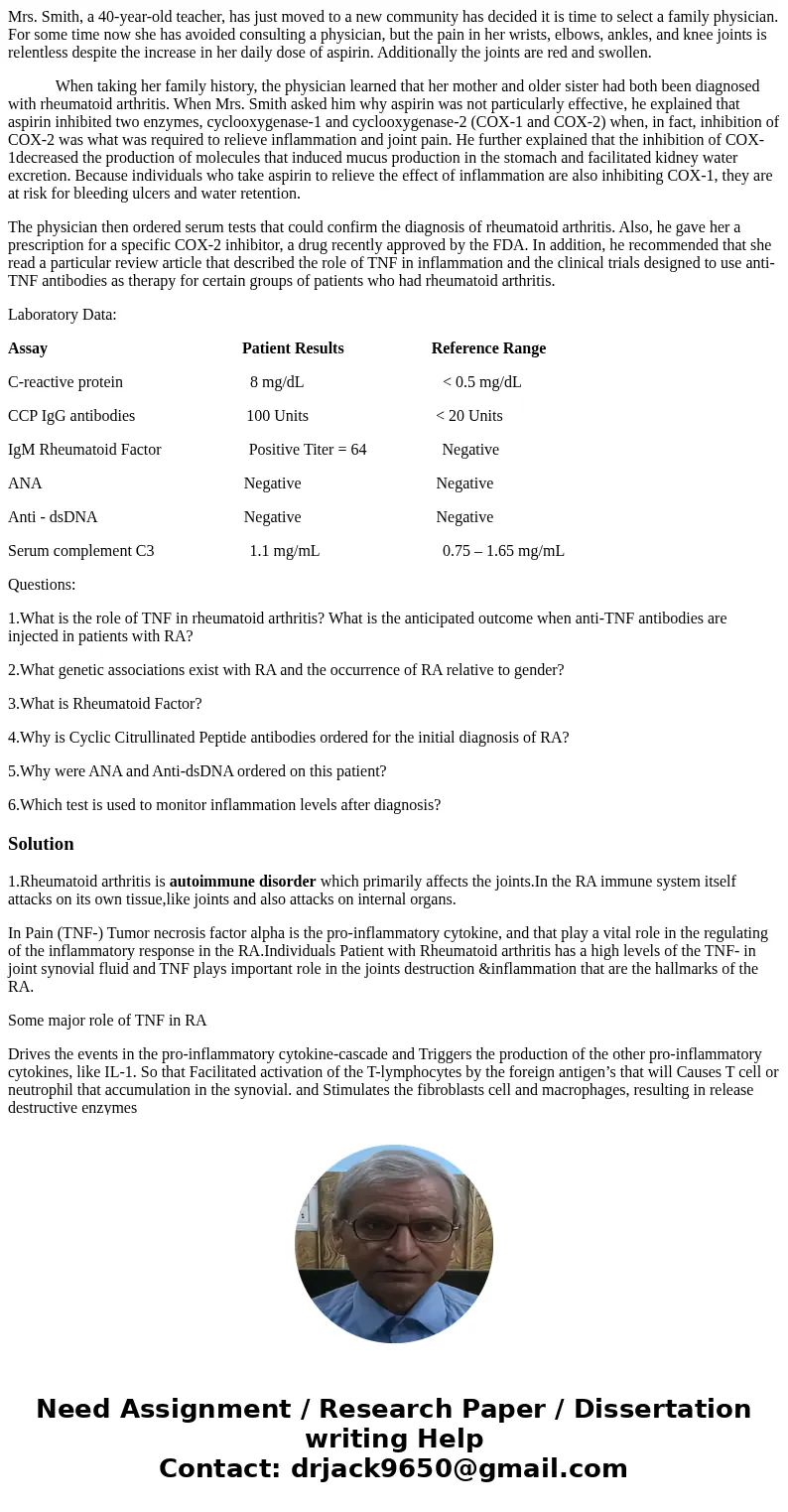Mrs Smith a 40yearold teacher has just moved to a new commun
Mrs. Smith, a 40-year-old teacher, has just moved to a new community has decided it is time to select a family physician. For some time now she has avoided consulting a physician, but the pain in her wrists, elbows, ankles, and knee joints is relentless despite the increase in her daily dose of aspirin. Additionally the joints are red and swollen.
When taking her family history, the physician learned that her mother and older sister had both been diagnosed with rheumatoid arthritis. When Mrs. Smith asked him why aspirin was not particularly effective, he explained that aspirin inhibited two enzymes, cyclooxygenase-1 and cyclooxygenase-2 (COX-1 and COX-2) when, in fact, inhibition of COX-2 was what was required to relieve inflammation and joint pain. He further explained that the inhibition of COX-1decreased the production of molecules that induced mucus production in the stomach and facilitated kidney water excretion. Because individuals who take aspirin to relieve the effect of inflammation are also inhibiting COX-1, they are at risk for bleeding ulcers and water retention.
The physician then ordered serum tests that could confirm the diagnosis of rheumatoid arthritis. Also, he gave her a prescription for a specific COX-2 inhibitor, a drug recently approved by the FDA. In addition, he recommended that she read a particular review article that described the role of TNF in inflammation and the clinical trials designed to use anti-TNF antibodies as therapy for certain groups of patients who had rheumatoid arthritis.
Laboratory Data:
Assay Patient Results Reference Range
C-reactive protein 8 mg/dL < 0.5 mg/dL
CCP IgG antibodies 100 Units < 20 Units
IgM Rheumatoid Factor Positive Titer = 64 Negative
ANA Negative Negative
Anti - dsDNA Negative Negative
Serum complement C3 1.1 mg/mL 0.75 – 1.65 mg/mL
Questions:
1.What is the role of TNF in rheumatoid arthritis? What is the anticipated outcome when anti-TNF antibodies are injected in patients with RA?
2.What genetic associations exist with RA and the occurrence of RA relative to gender?
3.What is Rheumatoid Factor?
4.Why is Cyclic Citrullinated Peptide antibodies ordered for the initial diagnosis of RA?
5.Why were ANA and Anti-dsDNA ordered on this patient?
6.Which test is used to monitor inflammation levels after diagnosis?
Solution
1.Rheumatoid arthritis is autoimmune disorder which primarily affects the joints.In the RA immune system itself attacks on its own tissue,like joints and also attacks on internal organs.
In Pain (TNF-) Tumor necrosis factor alpha is the pro-inflammatory cytokine, and that play a vital role in the regulating of the inflammatory response in the RA.Individuals Patient with Rheumatoid arthritis has a high levels of the TNF- in joint synovial fluid and TNF plays important role in the joints destruction &inflammation that are the hallmarks of the RA.
Some major role of TNF in RA
Drives the events in the pro-inflammatory cytokine-cascade and Triggers the production of the other pro-inflammatory cytokines, like IL-1. So that Facilitated activation of the T-lymphocytes by the foreign antigen’s that will Causes T cell or neutrophil that accumulation in the synovial. and Stimulates the fibroblasts cell and macrophages, resulting in release destructive enzymes
And Anti TNF- abs therapys induces shifting the equilibrium of cytokine, so producing more or high anti-inflammatory cytokines. Some Studies have been demonstrated that drastically improvement in the synovial inflammation, RA patients And treatment with the neutralizing (anti-TNF- Abs) or the soluble [TNF receptors], & the decreased [less] joint destruction after the treatment with the interleukin factor-IL-1Ra.
2.What genetic associations exist with RA and the occurrence of RA relative to gender-
RA is systemic autoimmune diseases, that characterized by the hyperplasia, synovial inflammation & auto-antibody production, bone or cartilage-destruction,
RA is the heritable disease, The [SNP] single nucleotide polymorphismhas is the standard genetic-marker for identify associated alleles in RA patient.
Occurrence of RA relatively in Epidemiology – female : male ration = 2-3:1, as compare to male female ration is high,
3.What is Rheumatoid Factor?
Rheumatoid factors [RA] are the protein that produced by patient immune system, which can attack on healthy tissue in the patient body. and High levels of the rheumatoid factor [RA] in blood are the most common associated with the autoimmune diseases, like Sjogren\'s syndrome & rheumatoid arthritis.
[Rheumatoid factor] RA is a auto-antibody [antibody directed against the own organism tissue] it was first found in the RA. It’s define a antibody against to the Fc portion of the IgG antibody & different RF can be recognize the different parts of IgG-Fc abs.
4.Why is Cyclic Citrullinated Peptide antibodies ordered for the initial diagnosis of RA
[anti-CCP]Antibodies to the cyclic-citrullinated-peptides are most widely use for the RA diagnosis. and this test is highest sensitivities, to detect RA,
Anti-CCP testing is clinically very useful tool for diagnosis & exclusion of
The RA in the patients with the polyarthritis. Those Patients which established the diagnosis for RA, if he show positive test for the anti-CCP antibodies and RF,and both are a higher risk of the developing erosive the joint damage& functional impairment.
5.Why were ANA and Anti-dsDNA ordered on this patient?
Anti-DNA antibody or Anti-nuclear antibody both are produce during the autoimmune disease like RA or SLE. And anti-dsDNA Abs are most demonstrated studied Abs of lupus related auto-antibodies. If we tested both ANA and Anti-dsDNA and both gives positive result than, we directly understand that the patient suffering from this kind of autoimmune disease like systemic lupus erythematosus[SLE]
6.Which test is used to monitor inflammation levels after diagnosis?
1. blood test, because patient blood have all the antibody or different Abs or several Cytokines factor or TNF-alpha, all of these required to confirmation of RA
C-reactive protein (CRP)
(ESR)Erythrocyte sedimentation rate ,


 Homework Sourse
Homework Sourse